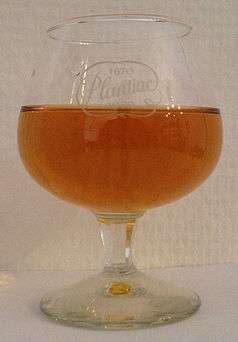Dutch brandy
 | |
| Type | Dutch Distilled |
|---|---|
| Manufacturer | Various, including Bols, Boomsma, Hooghoudt, Wenneker |
| Country of origin | Netherlands |
| Introduced | Early 20th century[1] |
| Alcohol by volume |
35% |
| Colour | White to dark brown |
| Flavour | Sweet, smooth, warm |
| Related products |
Cognac |
Dutch brandy (in Dutch: Vieux /vjø:/) is a Dutch distilled spirit that had been named as a type of cognac until that name was legally restricted to grape brandy from the Cognac region of France. It had been named (in Dutch) "Koetsiertje" or "Koetsierscognac" (as in cognac drunk by carriage riders - Dutch "koetsiers") or "Hollandse Cognac" ("Dutch Cognac"). Dutch Cognac is neither from the Cognac region, nor made from grapes. The colour ranges from clear to dark brown.
Production
Dutch brandy is based on either grain or molasses alcohol, with added essences and extracts to produce a particular taste. These essences and extracts may include fusel oil, amyl alcohols, vanilla, esters, oak curls, prune extract and the concentrated liquids that can be obtained from the roots of the liquorice plant (Glycyrrhiza glabra, Dutch "zoethoutwortel").
Any Dutch brandy is supposed to contain at least 35% of alcohol, and not more than 20 grammes of sugar per litre.[2] Usually, a little real cognac, eau-de-vie or other grape-based distilled product is added. The brown colour of vieux can be obtained using caramel or an artificial colouring.[3]
History
Although the Treaty of Versailles (1919) already forbade use of the name "Cognac" from being used for products produced outside of the French Cognac region, Dutch brandy used to be sold under the cognac name until the 1960s. The packaging (often including stars) was clearly derived from cognac packaging. Pressure from the French government led to a law that did not allow the name "cognac" to be used; it was ratified by the Dutch Supreme Court in a trade treaty with France on 1 June 1956.[4]
Dutch brandy producers decided upon the name "vieux", which had already been used before – it is French for "old" and was often used to describe old Dutch brandy ("Cognac Vieux") – and which did not provide any pronunciation difficulties.
Although its manufacturers feared a decline in sales due to the name change, the opposite turned out to be true. Dutch brandy also became popular to mix with cola, though older people tend to prefer it by itself, or with coffee.[5]
Initially Dutch brandy had a cheaper public image than cognac. Therefore, most manufacturers opted for not using their real name for Dutch brandy products. Lucas Bols, for example, used the name "Parade Vieux" (with the Dutch advertisement slogan "Pa pakt Parade" – "Dad picks Parade"). They even disclaimed production by crediting it as being produced by "Distillery Westertoren" rather than the official name of their facility. After Dutch brandy had lost its shady public image, the Parade name was changed to "Bols Vieux".
Statistics
In 2009 Dutch brandy was the fifth most popular distilled beverage in the Netherlands by consumption percentage (after Jonge Jenever, Whisky, Liqueur and rum) at 5,9% market share (at a par with Beerenburg).[6]
Companies and brands
Dutch brandy is made by a variety of distilleries, though several of them are owned (at least in name) by the Herman Jansen group (previously UTO). Vieux brands include Het Anker, Bestevaer, Bootz (made by Bols), Boots, Dujardin (made by Wenneker, who sell their regular 35% "Dujardin Blue label" as well as the more exclusive 38% "Vieux Superieur Gold Label"), Floryn, Henkes (made by Bols), Hooghoudt, Hoppe (made by Bols), Hulsink, Klasse A (house brand of Dutch liquor shop Mitra), De Kuyper, Legner Fine Vieille (not officially named "Vieux" as it only contains 30% of alcohol), Olifant and Plantiac (made by Boomsma).
In popular culture
In the early 1990s, Dutch brandy (in particular the Plantiac brand) enjoyed a brief period of Atari ST scene popularity.[7]
References
- ↑ "History of Vieux". Pdcg.nl. Retrieved 2012-10-22.
- ↑ "Vieux Informatie Merken Ingredienten Soorten Herkomst en Alcoholpercentage". Zoekenvindalles.nl. Retrieved 2012-10-22.
- ↑ "Commissie Gedistilleerd" (pdf). Pdcg.nl. Retrieved 2012-10-22.
- ↑ Juridische Aspecten van Geografische Aanduidingen, Barbara M. Vroom-Cramer, Kluwer BV, 2002, ISBN 90-268-4135-3
- ↑ "Vieux - wenneker". Wenneker.nl. Retrieved 2012-10-22.
- ↑ "Kerncijfers en Activiteiten 2009" (pdf). Pdcg.nl. Retrieved 2012-10-22.
- ↑ "The Ultimate ST NEWS Reference Guide". St-news.com. Retrieved 2012-10-22.
External links
- Bols Official Site
- Boomsma Official Site
- Hooghoudt Official Site
- De Kuyper Official site
- Plantiac aficionado site
- Wenneker Official Site


